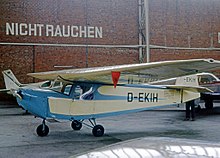Heini Dittmar
Heini Dittmar (born March 30, 1911 in Bad Kissingen , Lower Franconia ; † April 28, 1960 near Mülheim an der Ruhr ) was a German glider pilot , rocket aircraft pilot , designer and test pilot .
education
Inspired by the example of his gliding brother Edgar , Dittmar did an apprenticeship at the German Research Institute for Glider Flight after leaving school. At the age of 18, he passed his A and B gliding test in 1929. In 1932, at the age of 21, he achieved the first victory in his class in the Rhön glider competition with a self-made glider ( Condor ) . Then he got involved as a research pilot.
Records
After successes in long-distance gliding Dittmar 1934, along with Hanna Reitsch and Wolf Hirth member of the German gliding expedition to Argentina , where he set a new world altitude record for gliders (on 16 February 1934 4350 m). In 1934 Dittmar set another long-distance world record with the Fafnir II and was awarded the Hindenburg Cup . In 1936 he made the first crossing of the Alps in a glider. Heini Dittmar crowned his career as a glider pilot with victory in the 1st international Rhön competition in 1937, which was later recognized as the 1st world championship in gliding. In addition, he was awarded the golden badge in gliding no. 1.
With the rocket aircraft Me 163 A-V4 KE + SW , Heini Dittmar reached 1003.67 km / h for the first time in a test flight on October 2, 1941 and was the first person to exceed the 1000 km / h mark in an airplane. On July 6, 1944, Heini Dittmar reached a speed of 1130 km / h with the Me 163 B V18 Komet VA + SP.
Self-made
He died in 1960 when he crashed on a test flight with his own design HD-153 Motor-Möwe near the Essen-Mülheim airfield . The machine, initially designed as a glider under the name HD 53 Möwe (later HD 153A-1 or HD 156A-1), had its first flight in 1953, but the type certification dragged on until 1957. In the end, only eight or nine HD 153 and seven HD 156 (more luxurious version of the HD 153) of the machines equipped with a 71 kW Continental C-90 engine were built.
Nazi reference
During and after the Second World War , Heini Dittmar worked as an aircraft designer and test pilot, but remained largely apolitical in the spirit of National Socialism . The National Socialists also took advantage of the enthusiasm for gliding that had arisen after the First World War to train young aviators and, not least, for the air force that was being established . Heini Dittmar, who, despite all his modesty, was also very popular abroad, represented the best possible advertisement for gliding through his appearance and successes, which was carried out with books about Dittmar's sporting achievements that were suitable for young people until the war.
Honors
In the city of his death, Mülheim an der Ruhr, as well as in Augsburg and Schweinfurt, streets bear his name (Heini-Dittmar-Straße), as do in Kiel-Holtenau (Dittmarweg).
literature
- Robert L. Carlsen: The flying VW. In: Everywhere. The great youth yearbook. Jg. 2, 1956/1957, ZDB -ID 749761-1 , pp. 234-242.
- "Kraftei" - The ride on the rocket. In: FliegerRevue X. No. 57 ( fliegerrevuex.aero ).
Web links
- Irene Meichsner: Deadly Passion - glider pilot Heini Dittmar died 50 years ago deutschlandfunk.de April 28, 2010
Individual evidence
- ^ Robert L. Carlsen: The flying VW. In: Everywhere. The great youth yearbook. Vol. 2, 1956/1957, ZDB -ID 749761-1 , p. 238.
- ↑ Heini Dittmar in the German Glider Museum
- ^ Rolf Wurster: 50 years of German powered aircraft . Books on Demand, Battenberg 2001, ISBN 3-8311-1854-X , pp. 8 .
- ↑ FliegerRevue. November 2009, pp. 54–57, Dittmar, Winter and Scheibe.
- ↑ Hans-G. Hilscher, Dietrich Bleihöfer: Dittmarweg. In: Kiel Street Lexicon. Continued since 2005 by the Office for Building Regulations, Surveying and Geoinformation of the State Capital Kiel, as of February 2017 ( kiel.de ).
| personal data | |
|---|---|
| SURNAME | Dittmar, Heini |
| BRIEF DESCRIPTION | German glider pilot |
| DATE OF BIRTH | March 30, 1911 |
| PLACE OF BIRTH | Bad Kissingen , Lower Franconia |
| DATE OF DEATH | April 28, 1960 |
| Place of death | near Mülheim an der Ruhr |
